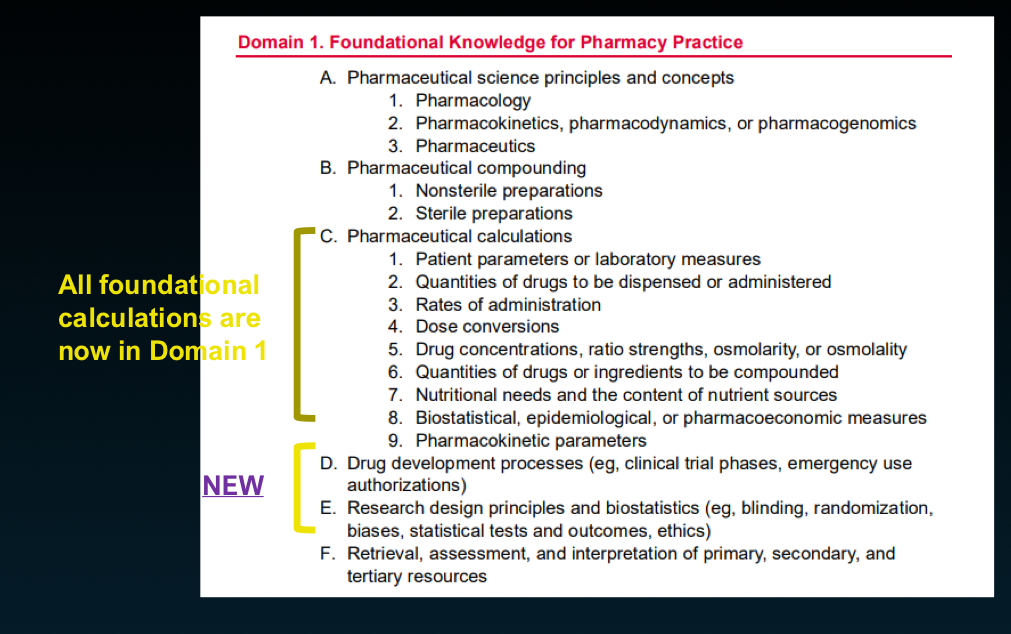The New Naplex and MJPE (last OTC lecture)
1/34
There's no tags or description
Looks like no tags are added yet.
Name | Mastery | Learn | Test | Matching | Spaced |
|---|
No study sessions yet.
35 Terms
Go to website for knowing key details on NAPLEX and MJPE
NABP
*both tests were developed by the NABP
What’s new with these exams?
New digital format
Non disclosure agreement must be accepted before starting exam
ID reqs: One primary current photo ID and signature
Palm vein scan is no longer a requirement
Section 5
How to apply
read bulletin and determine licensure Requirements
Apply for eligibility
Purchase exam
Schedule your exam (can take 45 days to have availability)
Section 8
Name matching reqs: updating e-profile with a name change
Section 9
Take your exams
Arrive early (this is expected. At least 30 min)
Bring ID
Security procedures
Inclement weather
Section 10
Exam results and other outcomes
review sample candidate performance report
Details about NAPLEX and mjpe results
Encourage students to allow results to be shared with MUSOP (provides more timely feedback of student performance.)
Complex application process Costs
Application for eligibility:
$100 for NAPLEX and $100 for each MJPE possible $85 for NABP eligibility state service
Purchase the exams:
NAPLEX— $520
MJPE— $170, per jurisdiction
NAPLEX format
computer based
6 hour exam time
On screen calculator and whiteboard
225 items (200 scored and 25 pre-test)
Two optional 10 min breaks
Exam can be scheduled with Pearson VUE six days per week.
What are the majority of questions formatted as?
Case questions
Types of questions you may see
MC
Constructed response questions
Multiple response questions
MJPE exam format
Computer based
2 ½ hrs
No calculator but whiteboard is available
120 items (100 scored and 20 pretest)
No breaks
Exam can be scheduled with Pearson VUE six days per week
MJPE readiness
What to study
old versions of the law books
pharmacist DEA Manual
Dr. C’s ultimate 2025 federal pharmacy law review
Waiting periods
NAPLEX: must wait 45days after fail to attempt to retake
MJPE: 30 days
Attempt limit
NAPLEX: 5
MJPE: 5 PER JURISDICTION
Limits per year
NAPLEX: candidates who have taken the exam 3 times in one year must wait 1 year from first attempt to retake the exam
Exam results
Pass/fail
Candidate performance reports
Only for failed NAPLEX and MJPE
How content outline is made
Phase 1: practicing pharmacists determine knowledge, skills, and abilities needed
Phase 2: survey administered to a large cohort of practicing pharmacists on key domain content
Phase 3: NABP content outline released
Phase 4: shared NAPLEX domain crosswalk
Phase 5: the NAPLEX content takes effect for NAPLEX exams.
NAPLEX competency areas until 5/1/25
Area 1 ~ 18%: obtain, interpret, or assess data, medical or patient info
Area 2 ~ 14%: identify drug characteristics
Area 3 ~ 35%: develop or manage treatment plans
Area 4 ~ 14%: calculations
Area 5 ~ 11%: compound, dispense, or administer drugs, or manage delivery systems
Area 6 ~ 7%: develop or manage practice or medication use systems to ensure safety and quality
The new domains
Foundational knowledge for pharmacy practice = 25%
Medication use process = 25%
Person centered assessment and treatment planning = 40%
Professional practice = 5%
Pharmacy management and leadership = 5%
Major changes for domain 1
All previous calculations are now in section 1C or domain 1 (knowledge for pharmacy practice.
Be familiar with what is new on this chart

Domain 2 ( med use process)
This domain is application focused
Immunizations are a big part
Dosage forms are a major component of practice exams
KNOW ALL FORMULATIONS AND APPROPRIATE BRAND NAMES.
Rybelsus
Oral semiglutide
Wegovy
SQ injection semaglutide
Zyprexa
Not the same as zyprexa relprevv
(Relprevv is a long acting injectable with a rems program)
Domain 3 (person centered assessment and treatment planning)
Mostly came questions
Some med use and storage questions
Some dosing, contraindications, warnings, evidence based decision making questions
Domain 4
What’s new is more ethical consideration questions
Key tools
Opioid stewardship
Antimicrobial stewardship
Social determinants and drivers of health
Opioid stewardship
CAGE-AID is a careening tool
Helps identify potential substance use disorders in adults and adolescents.
Antimicrobial stewardship
Reduce unnecessary use of Antimicrobials
Promote use of agents that are less likely to select for resistant microorganisms
Consider local susceptibility patterns
Social determinants of health
Economic stability
Education access
Housing stability
Food security
Transportation access
Social and community context
Language barriers
Discrimination and racism
Domain 5 (pharmacy management and leadership)
New items:
Inventory and supply management
Mentorship and preceptorship
NAPLEX domain achievement levels
Level 1– far below requirements
Level 2 — just below requirements to pass
Level 3 — passing
Level 4 — exceeds minimum requirements
How dumb was this lecture and class?
Excruciatingly dumb